“Vacation & recreation without humiliation”: Travelling through Segregated America
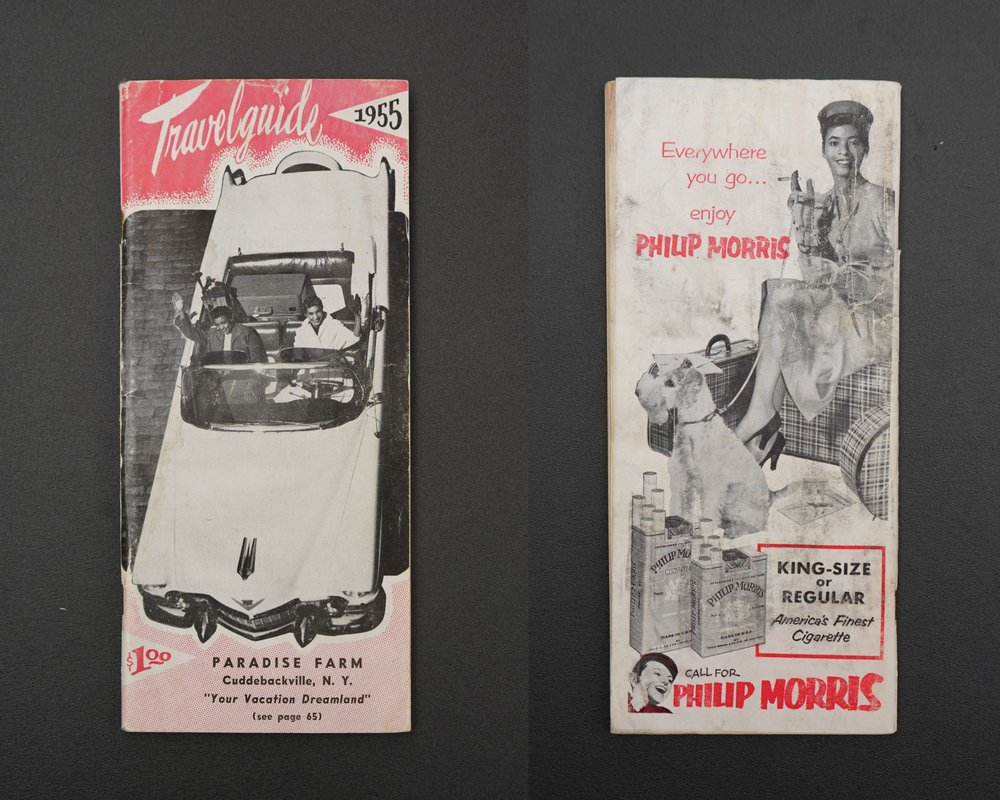
Front and back cover of Travelguide: Vacation & recreation without humiliation
by Iman Jamison G’ 26, School of Information Studies, and SCRC Graduate Instructional Assistant
Traveling has always been the foundation of my summertime. As a child, my mother would pack us into the car and go wherever there was a beach and a good time. In fact, my entire family, including myself, enjoys a good road trip. I’m reminded of my grandfather who has certain rules for success: leave as soon as the sun rises, have a playlist ready with every song you can think of and always pack a lunch because there is no stopping. I remember hours on the road, stopping only for gas and the bathroom, and a certain shoebox of leftover fried chicken from the night before. Growing up, I was always told shoeboxes were the best vessel for keeping fried chicken crispy, but for my grandfather, and many of my ancestors, it was an inconspicuous means of survival and a declaration of resilience.
Black Americans, for a long time, have faced the realities of feeling unsafe in public establishments due to discriminatory laws and practices originating during the Jim Crow era. Black families would pack lunches in shoeboxes for safety that was often at risk when attempting to order food in unknown spaces. The history of shoebox lunches represents a history of travel discrimination that pervaded America from the end of the Civil War and into the 1950s.
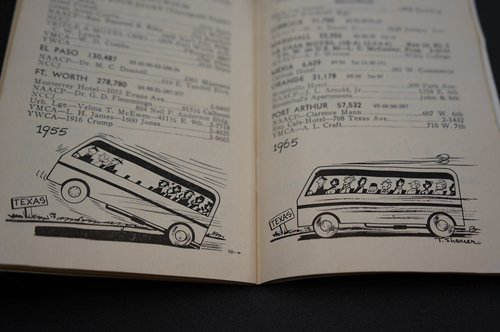
Cartoon graphic within Travelguide drawn by African American cartoonist Thaddeus Shearer, depicting the realities of segregation in 1955 and his hopes for 1965.
As I recall my own Black cultural experiences, I dived deeper into an artifact that embodies this component of Black history housed at SCRC called the Travelguide: Vacation & recreation without humiliation which acts as a cultural artifact of rebellion leading up to the Civil Rights Movement.
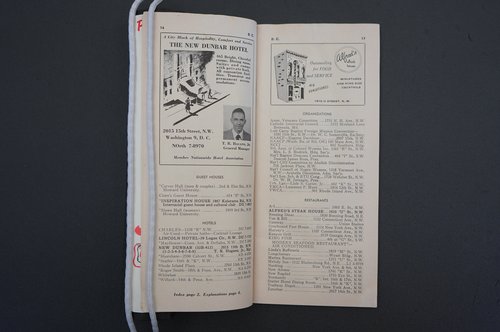
Page 16 and 17 of the Travelguide depicting advertisements and listings for hotels, restaurants and Black organizations in Washington, D. C.
Founded by Black musician and travel editor William “Billy” H. Butler in 1947, the Special Collections Research Center’s edition of the Travelguide was published in 1955 and was one of the last editions of the guidebook before ceasing publication in 1957. Despite its short-lived circulation, it existed as one of many travel guidebooks at the time that transformed what it meant for Black people to travel across the country and the world. One such counterpart would be The Negro Motorist Green Book which was published for 30 years starting in 1936 and received national popularity and recognition at the time of publishing as well as in recent years in popular culture.
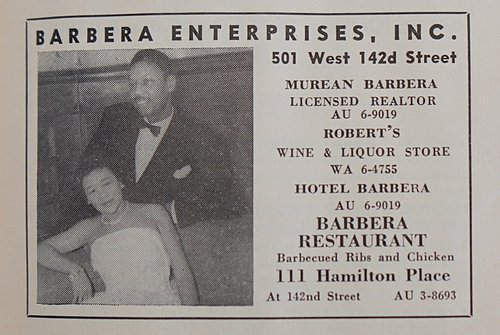
Advertisement for Barbera Enterprises, Inc. and the multitude of businesses located in New York City, New York and owned by the Barbera couple pictured to the left.
Immediately, the Travelguide resembles Black popular magazines at the time such as Ebony or Jet, with two Black women in a lavish car as the front cover and ads for household items and cigarettes dispersed throughout the material. However, beyond the advertisements there is a spirit of entrepreneurship and emphasis on Black-owned and Black-friendly businesses in major cities across the country. Businesses such as hotels, resorts, guest houses and restaurants are highlighted as well as beauty shops and salons, theatres, community centres, drug stores and even the occasional florist.
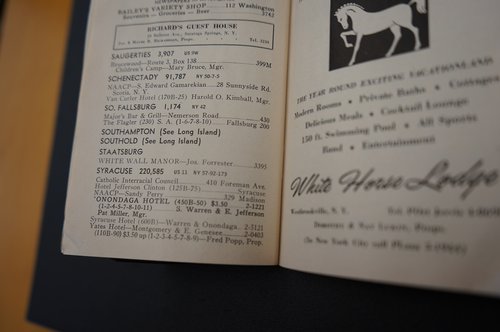
Black-friendly hotels and organizations listed for Syracuse, NY
Even listings for local hotels here in Syracuse made the Travelguide for safe options for Black Americans travelling through the area, including the Hotel Jefferson Clinton, which is still in operation today.
I was also particularly interested in the emphasis on civil rights organizations such as the NAACP and the National Urban League and the choice to highlight specific chapters across the country which acted as other safe harbors when travelling. Similarly, community centers and churches that were, and still are, elements of a network for African Americans to gain community, to organize and to find respite from discrimination. Each listing was carefully chosen to provide readers with reliable options when travelling and, like shoebox lunches, became a significant aspect of Black travel.
However, among the lighthearted ads and beautiful spirit of self-reliance within the Black community, there’s also the reality of insecurity that comes with simply “driving while Black” which is also highlighted in the book. Below each state, there is a description of their laws relating to discrimination and the legal expectation of “full and equal privileges…in places of public accommodation” with the actuality of that law “not been invoked since the Reconstruction Period,” as is the case with the state of Louisiana in 1955. In just a few sentences, the state of racially segregated America is remembered and realized all too well.
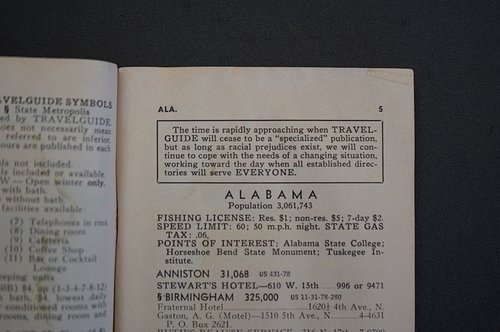
An excerpt in the Travelguide at the beginning of the business listings, highlighting the important purpose of this guidebook.
I’m privileged to say that traveling and the occasional road trip is forever a part of my summertime, but remembering shoebox lunches with my grandfather and materials such as the Travelguide remind me of the acts of nonconformity that my ancestors went through to give me that privilege.
The empowering yet serious tone of the guide also reminds me of the feeling of insecurity I still have when driving and existing in this country despite progress made.
To reflect on what travel means to me as a Black woman in America is to reconcile with how travel has always been intertwined with the African diaspora as a forced existence, means of escape or an act of rebellion against those that would rather us stay at home and inside; the Travelguide is just one such act.
References & Further Reading
https://www.pastemagazine.com/food/soul-food/celebrating-the-african-american-shoebox-lunch
https://savingplaces.org/stories/travelguide-vacation-and-recreation-without-humiliation
https://negromotoristgreenbook.si.edu/virtual-exhibit/
https://libguides.nypl.org/greenbook/welcome
https://www.atlasobscura.com/articles/what-is-a-shoebox-lunch
https://nmaahc.si.edu/explore/stories/traveling-through-jim-crow-america
https://urbanfaith.com/traveling-while-black-guidebooks-may-be-out-of-print-but-still-resonate-today/
https://www.nytimes.com/1981/03/24/obituaries/william-h-butler-77-musician-arranger-for-fletcher-henderson.html
https://www.tcj.com/ted-shearer-and-his-visual-masterpiece-quincy/
